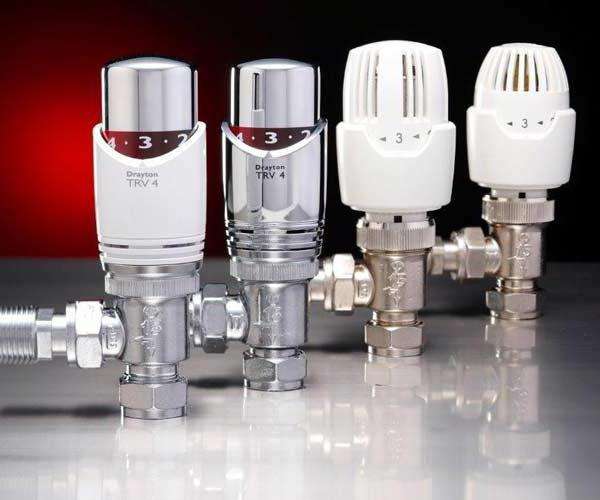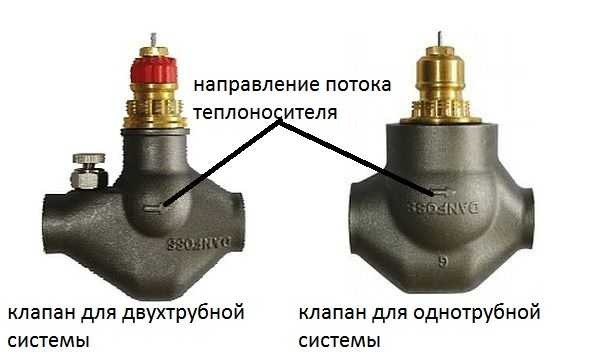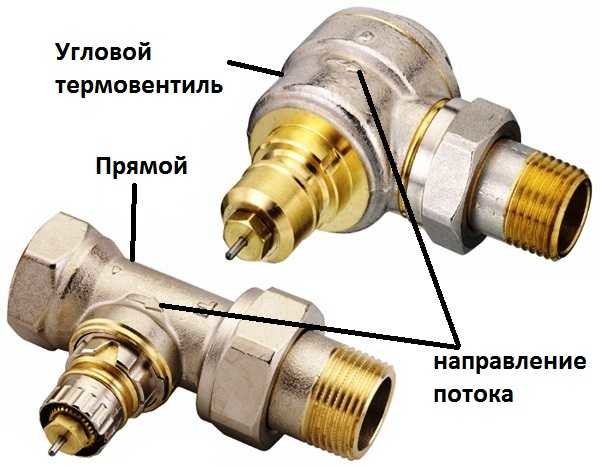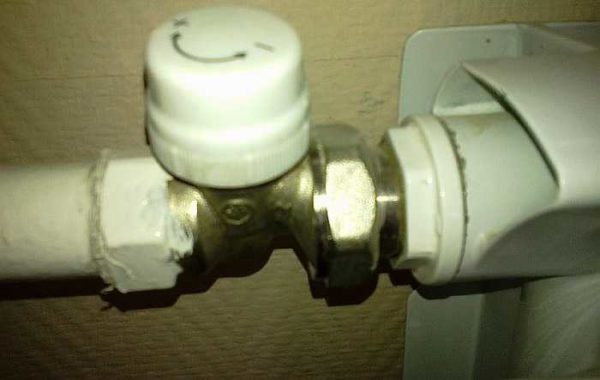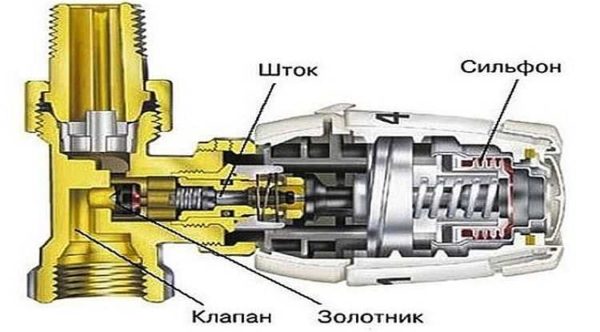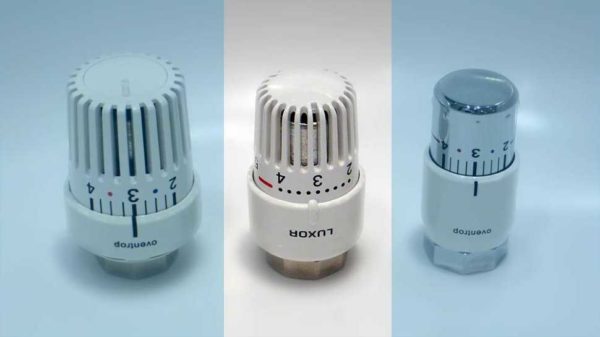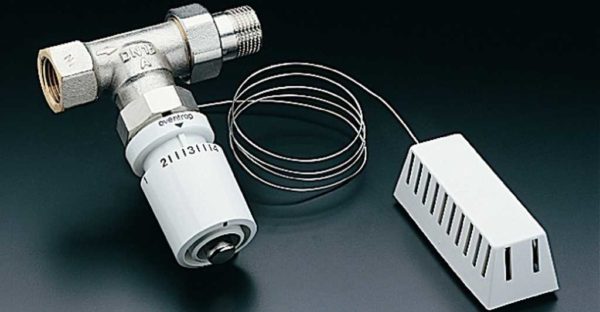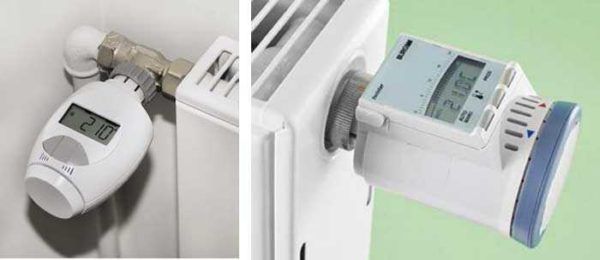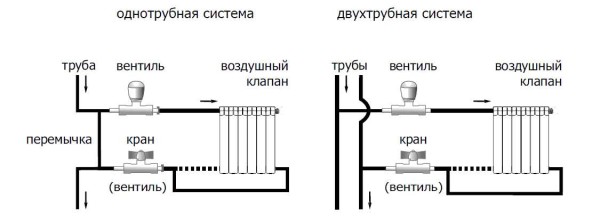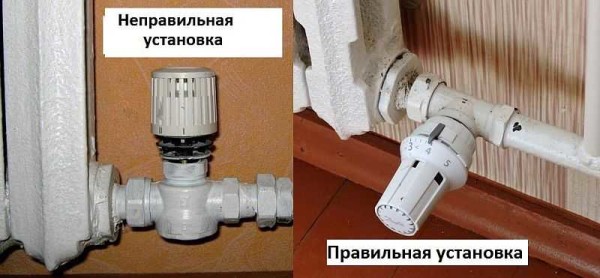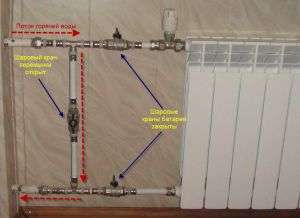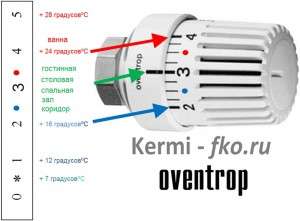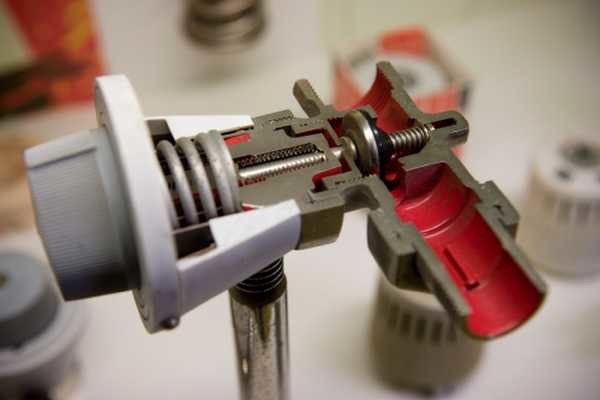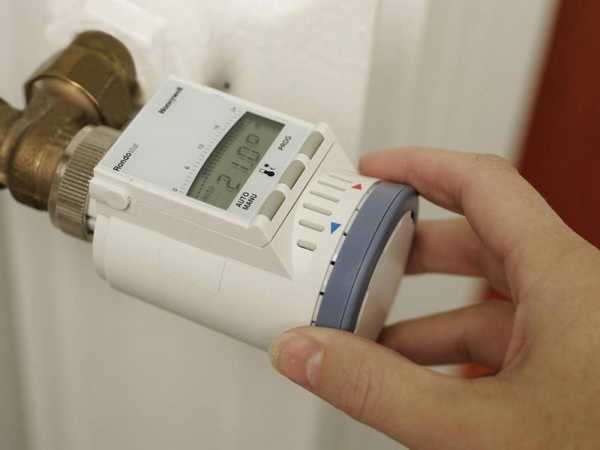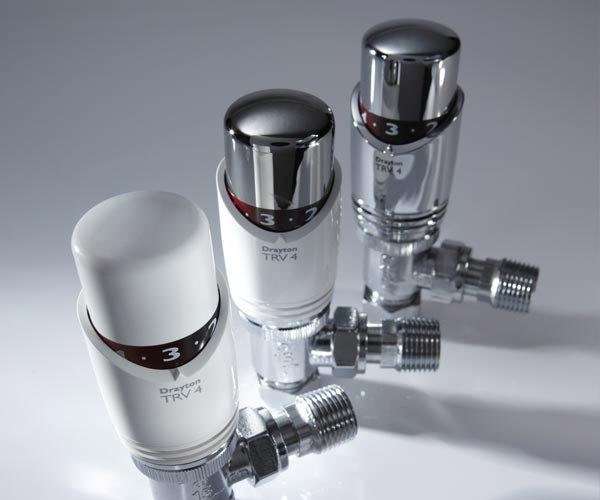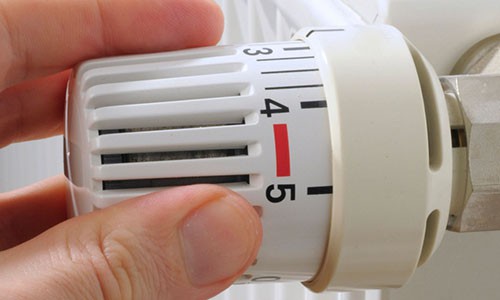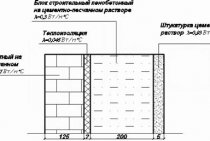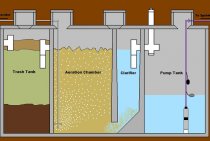Types of elements
Only the upper replaceable part of the device is called a thermal head. It can be manual, mechanical type and electronic. Most major manufacturers of this kind of equipment make the valve body fully compatible with all types of thermocouples.
So, if the radiator has a built-in thermostatic valve, then any type of head can be installed on it. The most reliable is a mechanical part equipped with a thermostat.
There are also models protected from vandalism. Systems with remote sensors are offered. Such solutions are purchased and installed if the current conditions do not allow temperature control on the radiator itself. For example, the battery is installed behind a cabinet or chest of drawers. The cost of such models starts from 40 euros.
Manual thermostats are the same radiator control valves. The principle of operation is the same here.
Thermal valve for heating radiator classification
Now let's talk about the bottom of the thermostat - the valve (valve). First of all, you need to know that the industry produces control devices for different systems. And you only need to use devices for your system.
Devices for two-pipe systems have at least twice the hydraulic resistance than for single-pipe systems. This is done on purpose, since balancing in this case occurs due to a pressure drop across the valves. Therefore, devices with a small flow area are installed. Putting such a device in a single-pipe system. you will surely be cold. Therefore, be careful.
There are thermal valves for the radiator in one-pipe and two-pipe systems. And it is impossible to use devices for a two-pipe system in a one-pipe system
Sometimes modifications for single-pipe systems are positioned as devices for systems with natural circulation. They have reduced hydraulic resistance, and they can be used in single tubes.
In a one-pipe system, install thermostats with a flow capacity of at least 3 (Kvs=3 and above).
According to the method of pipe connection, radiator temperature controllers are angular or straight (through). There are also axial models. Select in this case depending on the type of connection of the heater. If the pipe fits from the side, it is more convenient to install a straight valve, if from below - one of the corner valves.
According to the type of connection, thermostatic valves for radiators are straight and angled
Thermal valves also differ in the material from which they are made. Use metals that have good resistance to corrosion. Some of them have an additional protective coating (usually nickel or chrome plating). So, thermostatic valves are made from:
- bronze, nickel-plated and chrome-plated;
- brass, nickel-plated;
- stainless steel.
It is clear that stainless steel is better, but such valves cost a lot, and are rarely found on sale.
thermostatic heads
There are three types of thermostatic elements for heating thermostats - manual, mechanical and electronic. All of them perform the same functions, but in different ways, provide different levels of comfort, and have different capabilities.
Manual thermostatic heads work like a regular faucet - turn the regulator in one direction or another, passing more or less coolant. The cheapest and most reliable, but not the most convenient devices. To change the heat transfer, you must manually turn the valve.
Manual thermal head - the easiest and most reliable option
These devices are quite inexpensive, they can be placed at the inlet and outlet of the heating radiator instead of ball valves. Any of them can be adjusted.
Mechanical
A more complex device that maintains the set temperature in automatic mode. The basis of this type of thermostatic head is a bellows. This is a small elastic cylinder that is filled with a temperature agent. A temperature agent is a gas or liquid that has a large coefficient of expansion - when heated, they greatly increase in volume.
Thermostat device for a heating radiator with a mechanical thermostatic head
The bellows supports the stem, blocking the flow area of the valve. Until the substance in the bellows is heated, the stem is raised. As the temperature rises, the cylinder begins to increase in size (gas or liquid expands), it presses on the rod, which more and more blocks the flow area. Less and less coolant passes through the radiator, it gradually cools down. The substance in the bellows also cools down, due to which the cylinder decreases in size, the rod rises, more coolant passes through the radiator, it starts to warm up a little. Then the cycle repeats.
gas or liquid
With such a device, the room temperature is fairly maintained at exactly +- 1°C, but in general the delta depends on how inert the material in the bellows is. It can be filled with some kind of gas or liquid. Gases respond faster to temperature changes, but are more difficult to produce technologically.
Liquid or gas bellows - no big difference
Liquids change volumes a little slower, but they are easier to produce. In general, the difference in the accuracy of maintaining the temperature is about half a degree, which is almost impossible to notice. As a result, most of the presented thermostats for heating radiators are equipped with thermal heads with liquid bellows.
With remote sensor
The mechanical thermostatic head must be installed so that it is directed into the room. This way the temperature is measured more accurately. Since they have a fairly decent size, this method of installation is not always possible. For these cases, you can put a thermostat for a heating radiator with a remote sensor. The temperature sensor is connected to the head with a capillary tube. You can place it at any point where you prefer to measure the air temperature.
With remote sensor
All changes in the heat transfer of the radiator will occur depending on the air temperature in the room. The only disadvantage of this solution is the high cost of such models. But the temperature is maintained more precisely.
Electronic
The size of the electronic thermostat for the heating radiator is even larger. The thermostatic element is even bigger. In addition to the electronic filling, two batteries are also installed in it.
Electronic thermostats for batteries are large
The movement of the stem in the valve in this case is controlled by a microprocessor. These models have a fairly large set of additional features. For example, the ability to set the temperature in the room by the hour. How is it fashionable to use? Doctors have long proven that it is better to sleep in a cool room. Therefore, at night you can program the temperature lower, and in the morning, when it's time to wake up, it can be set higher. Conveniently.
The disadvantage of these models is their large size, the need to monitor the discharge of batteries (enough for several years of operation) and the high price.
Types of heat agent
Most often, liquid and gas are used in its role. Because of this, the following types of thermal heads are distinguished:
Cheaper and simpler are the regulators of the first type. For this reason, they are represented by a very large number of models. However, they manage the battery more slowly.
The gas regulator for the heating battery has a lower inertia, due to which it is able to quickly respond to changes in the temperature in the room.
In practice, the difference between the two types of reaction is very small.
Therefore, when choosing, it is better to focus on the quality of performance. It also depends on the manufacturer.
Almost all types of thermostats are able to set the temperature, the range of which is +6 ... +28 ° С. Of course, there are options designed to set other temperature levels. However, as the temperature range increases, the price rises.
Types of heads by design
There are thermostatic devices according to the type of design. They are selected depending on the characteristics of the pipeline of a particular heating system and the method of installation to the radiator.
It is necessary to take into account the peculiarity of the installation of the head. This node was always located horizontally. In this position, the device will be more efficient. The head can be better washed by air currents.
On sale there are devices independent without radiator valves or with them. The Danfoss thermostatic valve, for example, has just such an arrangement. But the company produces completely different systems. Instead of a scale on this product, a special scheme is applied, according to which you can accurately adjust.
But it is not always advisable to use such equipment. In this case, instead of automatic solutions, other types of gates can be used. The difference here is that the adjustment is carried out not in automatic, but in manual mode. Adjustable valves and thermal heads are installed on the supply line. At the return outlet of the battery, it is recommended to install simpler fittings.
Thermostatic heads
- devices of a cylindrical shape, inside of which there is a working substance that reacts to changes in air temperature. When the temperature changes, the volume of the working substance changes, as a result of which the valve overlaps. Typically, thermostatic heads regulate the temperature in the range from -6 to +30 degrees.
Thermal heads can have different working media (liquid, gas, etc.). The range of Heimeier liquid thermostatic heads is very large. Their main advantage is an increased level of accuracy, silent operation, simplicity and ease of use.
Gas-condensate thermal heads are more sensitive to temperature changes and react faster to its changes in the room.
Most of the models of thermal heads are equipped with built-in or remote sensors, which are respectively located in the body of the thermostatic head or outside (connection to the sensor is made using a thin metal tube).
It should be remembered that the installation of thermal heads with a built-in sensor is not so simple. In order for this type of thermostatic head to work with maximum efficiency, the following conditions must be met: a radiator depth of at least 16 cm, a window sill width of no more than 22 cm, and a distance from the window sill to the radiator of no more than 10 cm. In cases where these requirements are not possible perform, it is recommended to use thermal heads with a remote sensor, which can be located at a distance of 2 to 8 meters from the thermal head.
Installing a thermostat on a radiator
Thermostats on the radiator are installed mainly on the supply before entering the heater. Each of the valves passes the coolant in one direction. Where the flow should go is shown by an arrow on the body. The coolant should flow exactly there. If connected incorrectly, the device will not work. Another question is that you can put a thermostat, both at the inlet and at the outlet, but observing the direction of flow. And in both cases they work the same way.
Options for connecting and installing control valves. But in order to be able to repair the radiator without stopping the system, you need to install a ball valve before the regulator (click on the picture to enlarge it)
It is worth paying attention to the manufacturer's recommendations regarding the installation height. Most models should be at a height of 40-60 cm from the floor
They are calibrated for temperatures at this level. But not everywhere the feed is top. Often radiators have a bottom connection. Then, in addition to the type of system (one-pipe or two-pipe), select the height of the installation. If such a model is not found, you can set a lower temperature on the thermal head. If you set the recommended one, it will be too hot, because below, in the floor area, the air is cooler, and the model is set to maintain the temperature measured at the height of the upper edge of the radiator. The second option is to configure the device yourself. The procedure is usually described in the passport, and we will describe the most common sequence of actions below. And the third option is to put a thermostat with a remote sensor on the battery. Then it doesn't matter at what height the thermal head stands. The main thing is the location of the sensor. But these models are much more expensive. If this is critical, it is better to adjust the regulator.
Please note that the thermostatic head must be turned horizontally (facing into the room). If it is welded up, then it is constantly in the stream of hot air that comes from the pipe
Therefore, the substance in the bellows is almost always heated, and the radiator is turned off. The result is that the room is cold.
For the device to work correctly, you need to install it "head" into the room
The situation is slightly better if the battery is installed in a niche, covered by a screen or curtain. The thermoelement is also "hot" but not so much. Here you can go in two ways: either set a high temperature on the regulator, or use a remote sensor. Models with remote thermal controllers are, of course, not cheap, but you can choose the point of control at your discretion.
Another thing to remember: when installing a bypass is required in a one-pipe system. And unregulated. Then, when the supply to the radiator is closed, the riser will not be blocked, and you will not receive “hello” from your neighbors.
Thermal valves also differ in the type of connection: they are with union nuts, there are with compression ones. Accordingly, they are joined with certain types of pipes. Usually, the specification or product description indicates the type of connection, as well as with which pipes it can be used.
Thermal valve features
It was previously mentioned that it is universal, that is, any type of thermal head can be installed on it. However, despite this, it has two varieties. They depend on which heating system the tap is to be used in. single pipe or double pipe.
Varieties of a thermal valve should not be neglected, because by installing a valve for a two-pipe system in a single-pipe system. the radiator will not warm up. The reason for this is that the shut-off valves for a 2-pipe system have a high flow resistance. In fact, it is twice that of valves for a 1-pipe system. To achieve such resistance, manufacturers make a small flow area. It also allows you to reduce the pressure on the valves and balance the pressure in the system. Because of this, under the condition of low pressure (typical for a 1-pipe system), little coolant flows through the valve.
For 1-pipe systems, valves with a capacity equal to or greater than 3 are suitable.
Mounting the electronic thermostat on the battery is very simple. To do this, perform the following steps:
- Block the riser and drain the water.
- A piece of pipe is cut off from the radiator. Its length must match the length of the thermostatic valve. In fact, the pipe is cut in one place.
- Dismantle the part of the pipe that remains in the radiator. These steps are not performed if the heating system is just being created or if there is a tap with the same dimensions as the desired valve.
- The fitting with an American is unscrewed from the thermal valve.
- The fitting is fixed in the radiator, and the base of the tap on the pipe.
- Apply a tap to the fitting in the radiator and tighten the American. The valve should be located so that the stem "looks" to the side.
- Fix an electronic or mechanical thermal head.
Installation features are as follows:
- the thermostat is usually placed on the inlet pipe. In this case, the arrow on it must coincide with the direction of movement of the coolant;
- The electronic device must always be in a horizontal position. It is forbidden to place the thermal head above the pipe. This is because the heat from the pipe will heat up the cylinder and cause unnecessary heat sink shutoff. The consequence is a cold room;
- most electronic and mechanical regulators are set to mount at a height of 40-60 cm. If you place them at a height of 10-15 cm (bottom battery connection), then the room will be too warm. You can solve the problem with the bottom connection by reconfiguring the thermostat, using a remote sensor, or buying a specially designed regulator;
- if the heating system is single-pipe, then it is correct to connect the inlet and outlet pipes with an additional pipe. That is, you need to create a bypass.
How to properly install the thermal head on the battery
Intermediate positions, when adjusting the flow of water, can lead to rapid wear of the locking mechanism and its leakage.
A cone valve is a more suitable "candidate", since this valve may not be fully opened / closed.
Important. The crane must be returned to its original position after a while
Adjustment is carried out manually.
Batteries are adjusted using an automatic regulator, otherwise, a thermostat, according to several schemes, depending on the type of heating system.
Thermostats for one-pipe heating systems
The principle of this regulation
They are installed only if there is a connecting part between the pipes (bypass), which ensures the constant movement of water in the battery to the radiator from the coolant.
Read more about the purpose, design of the bypass here: http://kvarremontnik.ru/bajjpas-dlya-otopleniya/
For any type of heating system, the thermostat is installed in front of the radiator / battery, strictly in a horizontal position. This compensates for the heating of the pipe and the thermostat.
When installing a control valve, it is necessary to take into account the direction of movement of the heat flow: with vertical pipelines, the installation of movement is carried out along them. On the valve, arrows indicate the direction of movement of the coolants.
When installing the regulator on a two-pipe system, the following general requirements are met:
- installation takes place at the place of the jumper (plug) between the batteries and the coolant supply pipe;
- connection is carried out with the heating system turned off and the water drained from the system;
- The thermostat must be installed strictly horizontally.
Special conditions for installing a thermostat
Thermostat example
The thermostat operates on the principle: when a certain temperature is reached, the gas inside the regulator expands, blocking or reducing the supply of hot water.
Therefore, special installation conditions are required in order for the heating radiators to be adjusted correctly:
- The thermostat must not be exposed to direct sunlight.
- It should not be covered by curtains, battery screens.
- The air in the room must be ventilated, especially near the device itself.
In addition, its operation is influenced by the temperature outside the room and sources of cold and heat.
Advice. First of all, it is better to install thermostats in rooms with strong temperature fluctuations (kitchens, living rooms), as well as in the upper floors of private houses.
Read more about thermostats and how to work with them.And here is a detailed material on the installation of equipment.
home comfort
Type of thermostatic elements
The thermal head for the radiator is the upper, replaceable part of the device. It can be of several types:
To be able to navigate the prices: European manufacturers sell mechanical thermal heads from 15 euros to 25 euros, there are anti-vandal models, they cost from 40 euros. There are devices with a remote sensor. They are set if the conditions do not allow to regulate the temperature on the radiator (for example, it is installed behind a cabinet, closed in a niche, etc.). Here, the length of the capillary tube, which connects the sensor to the thermostat, is of great importance. Prices in this segment are from 40-50 euros.
It looks like a manual device for adjusting the temperature of radiators in the context
A manual thermostat is the same control valve for a radiator. And the principle of operation is the same: turn the knob, change the amount of passing coolant. The only difference is that if you wish, you can simply remove this thermocouple and install a mechanical or electronic one. The case does not need to be unscrewed or changed. They are universal. Heads for manual adjustment have a low price - from 4 euros.
Electronic thermal heads are the most expensive options, they are also the most massive: there is room for two batteries in the case. They differ in that they have more options. In addition to maintaining a stable temperature throughout the entire time, you can program the temperature by day of the week or by time of day. For example, after 9 am, all household members disperse, and appear only after 6 pm. It turns out that there is no need to spend money on maintaining a high temperature during the daytime. Electronic thermoelements and make it possible to set a lower temperature during this period on all days except weekends. Set at least 6-8 ° C, and in the evening you can again heat the air to a comfortable 20 degrees. With these devices, it is possible to save on heating without compromising comfort levels.
Electronic models have a much wider functionality
Thermal heads are also divided according to the type of temperature agent (substance that is in the bellows). They are:
The gas thermostat is considered less inertial, they say it responds faster to temperature changes. But the difference is not so big as to give preference to a specific species. The main thing is the quality, not the type of temperature agent. Liquid thermostats are no less high quality. Moreover, they are easier to manufacture, therefore they are produced in a wider range.
When choosing a thermocouple, you need to pay attention to the temperature range that the device can support. Usually it is from +6 o C to +26-28 o C
But there may be differences. The wider the range, the higher the price. Dimensions and design, connection method also change.
How does a thermal valve work
The thermal head is needed to regulate the temperature of the radiator.
The very first versions of thermostats that were installed on heating radiators were created in 1943 by DANFOSS. After several decades, such devices have undergone many changes, as a result of which they have become more accurate. Their design consists of several parts: a valve and a thermal head. At the same time, they are connected by a special locking mechanism. The purpose of the thermal head itself is to measure and analyze the temperature and influence it by using a valve mechanism for this mechanism that opens and closes the flow of water to the radiator.
This adjustment method is also called quantitative due to the fact that the device changes the temperature by changing the amount of coolant that passes through the heating radiator. There is also another method, which is called qualitative. Its principle is to change the temperature of the water directly in the system itself.The mixing unit, which is usually installed in the boiler room, is responsible for this.
Inside such an element is a bellows, which is filled with a temperature-sensitive medium.
In this case, the latter can be of several types:
- liquid;
- gas-filled.
It should be noted that liquid versions are easier to manufacture, but their performance is lower than that of gas ones. The essence of their work is as follows: as the temperature rises, the substance inside expands according to the laws of physics, due to which the bellows stretches. Further, the latter reduces the size of the valve section by moving a special cone. Ultimately, the coolant consumption is reduced. When the air in the room cools, the process is reversed.
Danfoss
This company is the inventor of the described equipment. For more than 60 years, the products of this manufacturer represent the best quality, high reliability and range. This technique can help you save a lot.
Among the popular products, one can single out the thermostatic valve RA-N. Designed for two-pipe systems, it has a built-in function to preset the capacity. The device is made in a durable cast bronze case and is protected from corrosion as much as possible.
As you can see, these solutions are a great option when you need to save on heating or when it is very hot in an apartment or house. These devices can make life more comfortable.
Cars Power steering belt: description and principle of operation
Each car has additional auxiliary devices - these are air conditioners, power steering, generators. All these elements are driven from the engine by means of drive belts. …
Cars Fuel supply system. Injection systems, description and principle of operation
The fuel supply system is needed for the supply of fuel from the gas tank, its further filtration, as well as the formation of an oxygen-fuel mixture with its transfer to the engine cylinders. There are currently several types…
Home comfort Impulse relays for lighting control: description and principle of operation
A relay is a device for switching an electrical circuit when input changes. The classic version is an electromechanical device that opens or closes contacts when passing ...
Home comfort Sofas, the mechanism of transformation "accordion": description and principle of operation
In modern apartments, sometimes there is not enough space to arrange all the necessary furniture. Therefore, sofas, transformation-type beds have become widespread. They perform many functions. This allows…
Home comfort Description and principle of operation of the Maxwell MW-1552 sandwich maker
In order to quickly and tasty feed the family at any time, the hostess does not need to be a great culinary specialist. It is enough for her to simply have a Maxwell MW-1552 sandwich maker in her kitchen. With its help, you can cook excellent se…
Technologies General description and principle of operation of multicookers
A multi-cooker is commonly called a multifunctional appliance, which belongs to kitchen appliances and allows you to automatically cook a wide variety of dishes. There are two main types…
Cars Vibration stand for car suspension diagnostics: description, features and principle of operation
Various malfunctions in vehicle suspension systems can lead to unpleasant consequences. The vehicle may skid when entering a turn and cause a serious accident. You need to understand that any...
Cars Turbo engine: description, characteristics, principle of operation and photo
Every motorist knows that internal combustion engines, according to their design and principle of operation, are divided into atmospheric and turbocharged.But not everyone understands the difference between these power units. Dave…
Business Clutch flywheel: description, types, purpose and principle of operation
Everyone knows that the main task of the engine is to convert energy into torque. Its transmission is carried out through a special flywheel of the clutch disc. This node is available in any car. How does he…
Business Piezoelectric sensor: description, acceleration, principle of operation and features
To obtain data on the temperature or pressure of the atmospheric medium, special sensors of the piezoelectric type are used. The main parameters of devices include not only the operating frequency, but conductivity, as well as ...
Principle of operation
Thermostatic valves basically represent a cylinder that is filled with a heat agent (this plumbing element is called a bellows). Liquid or gases can be used as a thermal reagent. But anything won't work for that. The volume of the coolant must depend on the temperature. There are also devices with solid components. However, they are not popular due to the long reaction time.
In the process of heating, the working substance begins to increase in volume, thereby stretching the cylinder. The latter begins to put pressure on the piston, which in turn drives the shut-off cone on the valve.
The cone completely or partially blocks the flow of the heat agent, which is why the working substance in the thermostatic head begins to cool. In the process of cooling, the volume of the substance decreases, and as a result, the elastic element raises the shut-off cone. The coolant will again flow into the heating radiator, and the head will heat up again.
So, thermostatic valves help to accurately control the temperature with high accuracy (up to one degree Celsius).
How to choose
When choosing a thermal valve, you need to take into account all the available features of the heating system
Based on the characteristics of the heating system, as well as the conditions of its installation, in order to control the temperature, it is possible to use various combinations of valves and thermal heads.
So, for example, for use in single-pipe systems, it is worth using valves with a higher throughput.
The same applies to those two-pipe systems in which water is circulated by gravity, that is, in a natural way, without forced mechanisms. In cases where a two-pipe system is used, where there is a circulation pump, it is recommended to choose those types of valves where it is possible to adjust the throughput.
After selecting the valve, it is necessary to select the thermal head.
The most common options that you can buy today are:
- having an internal thermoelement;
- electronic (which can be programmed);
- having an external temperature sensor;
- anti-vandal;
- with an external controller.
Most often, classic thermostats with an internal version of the sensor are installed in cases where their axis is in a horizontal position.
Please note: the thermostat must not be installed vertically, as the heat emanating from the body piping will greatly affect the bellows, due to which the entire device will not function correctly.
In cases where it is not possible to carry out horizontal mounting of the head, it is best to install an additional remote temperature sensor with a special capillary tube.
In addition to vertical mounting options, there are also other reasons to buy a remote version of the sensor:
- in the event that heating radiators with a temperature controller located on them will be located behind the curtains;
- when there is any other heat source near the installed thermal head;
- if the location of the battery is under a large window sill.
Very often, in those rooms where the requirements for the interior are increased, the batteries are covered with decorative screens. Due to this, the internal thermostat will register only the temperature that is inside this casing. This will block access to the thermal head adjustments. Therefore, in such cases, it is recommended to opt for a remote controller with a temperature sensor.
Worth knowing: if you have not yet purchased heating radiators, you can buy Kermi models with already built-in temperature sensors.
If we talk about electronic thermostats with a display, then they are of several types, the first has a built-in control unit, and the second has a removable one. The latter have the feature of being able to detach from the thermal head, while it will continue to work in the same mode. The purpose of such models is the implementation of temperature control in different modes, at different times of the day. This makes it possible to reduce the level of heat during the day, and at night, when everyone in the house is asleep, raise it to the desired level. Due to this, it is possible to significantly save energy.
If there are small children in the family who always want to touch and twist everything, it is recommended to install anti-vandal thermostats. This will protect the device settings from unauthorized interference. The same situation applies to options installed in various public buildings, from kindergartens to hospitals.
Setting the thermostat
To set the temperature controller correctly, the temperature must be reduced to the minimum possible heat loss in the room. The thermometer should be located where the temperature will be constant. After that, we scroll the head of the thermal regulator to the left to the end, opening the valve, as a result of which maximum heat transfer is achieved. As soon as the temperature increases by 5-6 degrees, the valve is closed by turning the head in the opposite direction
After reaching the desired temperature level, we begin to carefully open the valve. The setting ends when the noise of water in the regulator is heard and the rapid heating of the valve is felt.
The installation of thermostats on heating radiators is best left to professionals who will connect according to the manufacturer's instructions. Properly installed equipment will create an optimal temperature regime in the room and ensure the rational consumption of thermal energy, which will positively affect the financial expenses of the family.
